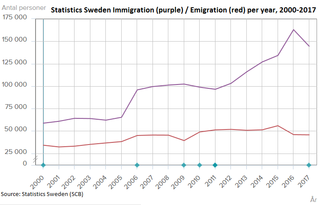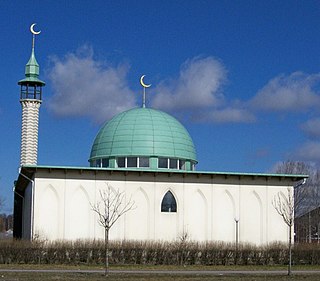
Demographic features of the population of the Netherlands include population density, ethnicity, education level, health of the population, economic status, religious affiliations and other aspects of the population.
Somalis in Finland are residents and citizens of Finland of Somali ancestry. As of 2022, 24,365 Finns had a Somali-background, making it the fourth most common foreign country of origin and the largest from Africa.

Immigration to Europe has a long history, but increased substantially after World War II. Western European countries, especially, saw high growth in immigration post 1945, and many European nations today have sizeable immigrant populations, both of European and non-European origin. In contemporary globalization, migrations to Europe have accelerated in speed and scale. Over the last decades, there has been an increase in negative attitudes towards immigration, and many studies have emphasized marked differences in the strength of anti-immigrant attitudes among European countries.
In 2017, Norway's immigrant population consisted of 883,751 people, making up 16.8% of the country's total population. Of this number, 724,987 are foreign-born, while 158,764 are Norwegian-born with foreign-born parents. The ten most common countries of origin of immigrants residing in Norway are Poland (97,197), Lithuania (37,638), Sweden (36,315), Somalia (28,696), Germany (24,601), Iraq (22,493), Syria (20,823), Philippines (20,537), Pakistan (19,973) and Eritrea (19,957). The immigrant population comprises people from a total of 221 countries and autonomous regions, but 25% of the immigrants are from one of four migrant groups: Polish, Lithuanians, Swedes and Somalis.
The Office of Immigration Statistics (OIS) is an agency of the United States Department of Homeland Security under the Office of Strategy, Policy, and Plans.

Immigration to Finland is the process by which people migrate to Finland to reside in the country. Some, but not all, become Finnish citizens. Immigration has been a major source of population growth and cultural change throughout much of the history of Finland. The economic, social, and political aspects of immigration have caused controversy regarding ethnicity, economic benefits, jobs for non-immigrants, settlement patterns, impact on upward social mobility, crime, and voting behaviour.

Immigration to Sweden is the process by which people migrate to Sweden to reside in the country. Many, but not all, become Swedish citizens. The economic, social, and political aspects of immigration have caused some controversy regarding ethnicity, economic benefits, jobs for non-immigrants, settlement patterns, impact on upward social mobility, violence, and voting behaviour.
African immigrants to Sweden include naturalized citizens and residents of Sweden who were born in Africa. As of 2020, there are 236,975 people in Sweden who were born in Africa. By 2022, this number rose to 250,881 residents of Sweden who were born in Africa, or approximately 3% of the total population.

Somalis in Sweden are citizens and residents of Sweden who are of Somali ancestry or are Somali citizens. A large proportion of these emigrated after the civil war in Somalia, with most arriving in Sweden after the year 2006.

Arabs in Sweden are citizens and residents of Sweden who emigrated from nations in the Arab world. They represent 5.3% of the total population of the country. About a quarter of Arabs in Sweden are Christians.
Denmark has seen an increase in immigration over the past 30 years, with a large part of the immigrants originating from non-Western countries. As of 2014, more than 8 percent of the population of Denmark consists of immigrants. As of Q2 of 2022, the population of immigrants is 652,495, excluding Danish born descendants of immigrants to Denmark. This shift in demographics has posed challenges to the nation as it attempts to address cultural and religious differences, labour shortages, employment gaps, education of immigrants and their descendants, spatial segregation, crime rates and language abilities.
Syrians in Sweden are citizens and residents of Sweden who are of Syrian descent. As of 2019, there were 191,530 residents of Sweden born in Syria, and 50,620 born in Sweden with at least one Syrian-born parent.
Eritreans in Sweden are citizens and residents of Sweden who are of Eritrean descent.
Ethiopians in Sweden are citizens and residents of Sweden who are of Ethiopian descent.
Eritreans in Norway are citizens and residents of Norway who are of Eritrean descent. Most have a background as asylum seekers that have fled Isaias Afwerkis regime.
Somalis in Norway are citizens and residents of Norway who are of Somali descent. They are the biggest African migration group in Norway. 36.5% of Somalis in Norway live in the capital Oslo. Almost all Somali in Norway have come to Norway as refugees from the Somali Civil War. In 2016, Somalis were the largest non-European migrant group in Norway.
Ethiopians in Norway are citizens and residents of Norway who are of Ethiopian descent.
Moroccans in Norway are citizens and residents of Norway who are of Moroccan descent.
Swedish Afghans are citizens and residents of Sweden who are of Afghan descent, part of the worldwide Afghan diaspora.
Moroccans in Denmark are citizens and residents of Denmark who are of Moroccan descent.







